BY: MORGAN REASE
Like many folks all over the world, I start my mornings with a cup of coffee…or three. I’ve had a few cups that were phenomenal, and many cups that I choked down just so I could stay awake. I attribute my experiences to baristas being “good at making coffee” or good beans. But what makes coffee flavor good or bad? Where does flavor really come from?

Heads up! I mention Ritual Roasters of San Francisco a lot in this article. They were kind enough to metaphorically hold my hand through the whole research process. They even let me do a few cuppings (coffee tastings) with them.
Growing:
Like the coffee bean itself, flavor starts on the tree. In his book The World Atlas of Coffee, James Hoffman asserts that the quality of coffee peaks on the tree and that all further processing is with the goal of preserving as much of that quality as possible.6 However, that is not to say that eating a coffee bean off the tree will taste of coffee as we know it, in fact its really not even terribly pleasant. A green bean tastes very vegetal and a lot like a dirt flavored un-popped popcorn kernel. Rather, a high quality, ripe coffee bean has all the constituents that allow it to become a high quality cup of coffee.
Some factors of the raw beans that affect the final cup include varietal, density, and ripeness. There are over 120 different species of coffee, but only two are commercially relevant: Coffea arabica and Coffea camephora (also known as Coffea robusta). Arabica is prized for its flavor and comprises 60% of the global coffee harvest.5 Robusta is relegated to the world of commodity coffees, though you can still get a decent cup of coffee from robusta beans.6

Figure 1: Global coffee growing regions, aka the Bean Belt Source: http://www.mankiracoffee.com.au/pages/why-ethiopian-coffee-beans
As you can surely guess, ripe beans make for better coffee than unripe beans. As such, how beans are harvested will indirectly affect your morning cup o’ joe. Beans can be harvested by hand or by machine. Hand harvesting is labor intensive and tedious, but allows the workers to pick only the ripe beans off the tree. However, workers too can harvest whole trees at once by stripping all the cherries regardless of ripeness. Machine harvesting collects all the beans at once, which relies on knowing when you get the most ripeness at a given time. Harvesting unripe and overripe beans together with ripe beans, although cheaper and faster, lowers the overall quality.6
Processing:
From picking, the beans move on to their first stage of processing. How the beans are dried makes a big difference in the coffee flavor profile, though varietals are still distinguishable.4 All initial processing methods, which are referred to using the generic term “wet processing”, comprise the basic steps of drying to 11-12% moisture, removing the fruit flesh, and removing the parchment.6
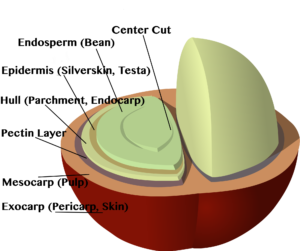
Figure 2: Anatomy of a coffee cherry. Image adapted from Wikimedia Commons
The main wet processing methods are listed below:6
The Natural/Dry Process: Whole coffee cherries are laid out in the sun and turned regularly to dry. Once dry, the cherries are depulped.
The Washed Process: Ripe cherries are mechanically depulped to remove the majority of the fruit flesh and then submerged in water to undergo a fermentation. The fermentation step is to facilitate the removal of any remaining flesh by allowing microbes to break it down. The beans are then rinsed to wash off the loosened flesh and laid out to dry in the sun.
The Pulped Natural Process: Ripe cherries are depulped and laid out to dry in the sun.
The Honey (Miel) Process: Ripe cherries are partially depulped and laid out to dry in the sun. This method is popular in Central America.
The Semi-Washed Wet Hulled Process: Cherries are depulped and dried to just 30-35% moisture and then have the parchment removed before undergoing a second drying to 10-11%. This process is popular in Indonesia.

In all processes, once the beans are dried, the beans will be rested for a period of 1-2 months before shipping. This resting is thought to produce beans that ship better and age better. The parchment will be removed (the exception being the semi-washed wet hulled process) after resting, but before shipping.4,6
The most traditional method of drying is the Natural/Dry Process and involves just spreading the cherries out along the ground. Poor air circulation leads to longer drying times and spoilage. The use of raised beds has greatly improved the ability to produce high-quality coffee with the dry process.2
In terms of coffee flavor, dry processed coffees tend to be fuller in body, sweeter, and more complex than wet processed coffees. However, beans processed in this method tend to produce lower quality coffee because the cherries are susceptible to molding and over-fermenting, both of which can produce undesirable flavors.2
Wet processed coffee produces cleaner, brighter coffee flavors and is generally the preferred method of coffee professionals. Without the cherry covering the bean, drying can occur much quicker, allowing the varietal characteristics to come through.2 Jeremy Kantor, another employee of Ritual Roasters in San Francisco, described washed coffees as being a fresh orange, and naturally processed coffees as a prune. Both are fruity he said, but it’s a much different kind of fruit.4
The semi-washed process gives the beans a deep, swamp green color, reduces the acidity and increases the body of the resultant brew. Furthermore, semi-washed coffees are associated with flavor descriptors such as tobacco, spice, wood, must, and earth, though whether or not it is a good thing is a matter of opinion.6
No single method of processing is best for every region, different processes work better in different parts of the world. Furthermore, some regions are restricted to only using the dry process due to limited water resources or limited equipment.2
Roasting:
Roasting the beans is where the coffee flavors we’re all familiar with start to come through. You’re likely familiar with the notion of light, medium, and dark roasted coffees. These terms arise from the degree of color change caused by the roasting process, but they are not fully indicative of the coffee flavors each roast possesses.
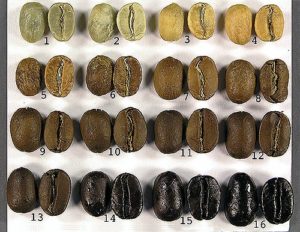
Figure 3: Appearance of beans at different stages of roasting.
Temperature of bean (F): 1 – 75; 2 – 270; 3 – 327; 4 – 345; 5 – 370; 6 – 393; 7 – 401; 8 – 415; 9 – 426; 10 – 435; 11 – 444; 12 – 454; 13 – 465; 14 – 474; 15 – 486; 16 – 497. 7-9 are first crack, 12-14 are second crack.12
Roasting is much much more than just waiting for the color to change. Longer roasting times allow the bean’s interior to undergo changes and become more flavorful. Roasts that are too short and hot can produce weak, acidic coffee.5 Roasts that are too long will lose the unique characteristics of the beans.
The first stage of roasting involves the drying of the green beans. High moisture content inhibits the maillard reaction taking place. Changes to the bean are relatively slow at the beginning of the roast as water is driven off by evaporation. As the beans become sufficiently dry, they begin to turn yellow and the chaff begins to separate from the bean. Chaff will be removed by air to a separate chamber of the roaster as chaff can easily burn and impart a smokey/burnt flavor to the coffee.6
Browning reactions begin to take place more quickly at this point.
Sucrose, which can be up to 9% of the bean’s weight5, undergoes carmelization between 338-392F. During the breakdown of sucrose, CO2 is produced, causing the bean to expand and crack. This process is referred to as “first crack” and is considered to be the point at which the roasting process has met its minimum length to produce quality coffee.11
Trigonelline is one of the compounds that contributes significant bitterness to coffee. It begins to degrade at temperatures of 378F. Balancing trigonelline with sugar is key to a good roast. One compound that trigonelline degrades into is nicotinic acid; also known as niacin or vitamin B3.12 Nicotinic acid contributes a different kind of acidity to coffee, providing a “clean” finish to the cup. It melts around 457F, and is thought to influence other reactions throughout the roasting process.11
Chlorogenic acids account for 4-9% of the total dry weight. The roasting process breaks down chlorogenic acids into other compounds, though the effect of acids themselves on coffee flavors is unclear. During a light roast, 45-54% of chlorogenic acids break down; medium roasts experience a 60% breakdown; dark roasts can lose up to 100% of their chlorogenic acid.10
Within the classificaton of chlorogenic acids is quinic acid. Quinic acid contributes a sharp brightness to coffee, has a relatively low melting temperature of 325F, but is actually stable throughout the roasting process.11
As the roast is allowed to progress, more browning reactions will take place and the varietal notes and grassy characteristic of the green coffee will be replaced by the coffee flavors of Maillard products.
High heats, temperatures of 446-536F, cause the breakdown of the cellulose and lignocellulose matrix of the beans. These temperatures are found with dark roasts. The breakdown causes the cell walls to degrade and lignocellulose to volatalize, resulting in the “second crack”.11 Second crack is considered the maximum extent to which one should roast coffee. Roasting beyond this point the beans can cause the beans to combust. During second crack beans will develop a glossy black sheen as the oils escape through the fractured matrix to the bean exterior. A roast this dark has lost all varietal characteristics.6

Brewing:
Brewing coffee is a process anyone who has worked in a lab should understand. Both because scientists drink the most coffee out of any profession, and because its simply a water extraction of ground sample (aka beans). When using different brewing methods, pour over to French press, Aeropress to Mokapot, the variables being altered are: grind size (surface area), extraction time, water temperature, and ratio of water to coffee.
Grind size can influence your cup by determining how fast the extraction takes place. Finer grinds will extract more quickly, while coarser grinds will take longer to extract the same amount.4,6 Your brew method also influences how fine the grind should be. A French press requires a coarse grind to reduce the amount of sediment in the final cup. With a pour over, a medium-fine grind is used because the filter should catch all but the smallest of particulates. Paper filters can also impact coffee flavors as they can absorb much of the lipophilic compounds present and thus prevent them from reaching your cup.5
Short extractions produce highly acidic coffee (ever have a gross acidic espresso? Yeah) because the acids are some of the first compounds to solubilize.4 Over-extracting your grounds with a long brew time produces bitter astringent coffee.
To illustrate this point, Aaron van der Groen (Ritual Coffee Roasters of SF) poured me what he called a “rainbow shot”. By separating the espresso shot into 6 segments, it allowed me to see (or taste) what coffee flavors come through during different stages of brewing. Using 9.5 bar of pressure, the total espresso extraction took 40 seconds. The first cup held the first 15 seconds, only 6 of which was coffee actually pouring into the cup. This is over-extracted, but emphasizes the coffee flavors that come through. Cup 1 tasted very bright and acidic, with a saltiness. Cup 2 was acidic and fruity. Cup 3 had a rounded, mellow flavor with chocolate notes. Cup 4 was sweet and full of roasty flavors. Cup 5 was weak and is the typical cut off for an espresso. Cup 6 was very bitter and astringent and had a layer of proteins that had precipitated out of solution floating on its surface.

Figure 5: The Rainbow Shot
Freshly ground coffee should be used whenever possible as pre-ground coffee can stale very quickly. Staling causes coffee to taste bland and cardboard due to the loss of aromatic compounds and oxidation of lipids.6
Water quality also has a big impact on the quality of the coffee produced, after all it does make up ~98.5% of each cup.7 Alkaline water can cause the coffee to taste bitter and flat. Brewing with hard water can affect the rate at which compounds are extracted, but water that is too pure also produces inferior cups.4 Another factor of water that influences the coffee quality is its temperature, with higher temperatures extracting the grounds more rapidly than cold water.
Serious brewing requires precision as the ratio of grounds to water is very important. A ratio of 1g:15g coffee to water is considered to be a good starting point and can be adjusted to suit your tastes (I like my coffee on the stronger side, so more total dissolved solids). The ratio, as well as the extraction time and other factors listed previously, affect the total dissolved solids (TDS) content of the cup. Only about 26% of the grounds are actually water soluble.4
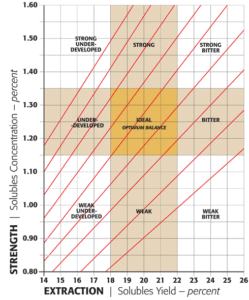
Figure 7: Total Dissolved Solids v Percent Extraction.
Drinking & Perception:
All these factors and more combine to make coffee the delicious incredible beverage that it is! The aroma of coffee is due to the delicate interplay of over 800 different chemical compounds.8 Some compounds considered to be especially important to overall aroma are listed in the table below.
| Compound | Odor Descriptors |
| 2,3-Butanedione | Buttery |
| 2,3-Pentanedione | Buttery/Caramel/Nutty |
| 1-Octen-3-one | Mushroom |
| 2-Hydroxy-3-methyl-2-ciclopentene-1-one | Sweet/Caramel |
| Propanal | Ethereal/Pungent/Earthy |
| 2-Methylpropanal | Spicy/Floral |
| 3-Methylpropanal | |
| 2-Methylbutanal | Buttery |
| 4-Methylbutanal | Buttery |
| Hexanal | Green/Vegetal/Woody |
| (E)-2-Nonenal | Buttery |
| Methional | Baked Potato |
| Methanethiol | Sulfur/Creamy |
| 4-Methyl-2-buteno-1-thiol | Tobacco/Roasted |
| 2-Methyl-4-furanthiol | Meat |
| 5-Dimethyl-trisulfide | Sulfur |
| 2-Furfurylthiol | Roasted |
| 2-Furanmethanthiol | Smoke/Roasted |
| 2-(Methylthiol)propanal | Soy Sauce |
| 2-(Methylthio-methyl)furan | Tobacco/Roasted |
| 3,5-Dihydro-4(2H)-thiophenone | Tobacco/Roasted |
| 2-Acetyl-2-tyazoline | Roasted |
| 4-Methylbutanoic | Sweet/Acidic |
| β-Damascene | Cooked Apple/Fruity/Sweet |
| 4-Hydroxy-2,5-dimethyl-4(2H)-furanone (furaneol) | Caramel/Sweet |
| 2-Ethyl-furaneol | Caramel |
| 4-Hydroxy-4,5-dimethyl-2(5H)-furanone (sotolon) | Spicy |
| 5-Ethyl-4-hydroxy-4-methyl-2(5H)-furanone (abexona) | Spicy |
| 2-Ethyl-4-hydroxy-5-methyl-4(5H)-furanone | Sweet/Caramel |
| 2-Methoxyphenol | Phenolic/Burnt |
| 4-Methoxyphenol | Phenolic |
| 4-Ethyl-2-methoxyphenol | Phenolic |
| 4-Vinyl-2-methoxyphenol | Clove |
| 4-Ethenyl-2-methoxyphenol | Phenolic |
| 3-Methylindole | Coconut |
| Vanilline | Vanilla |
| 2,3-Dimethylpyrazine | Nutty/Roasted |
| 2,5-Dimethylpyrazine | Nutty/Roasted |
| 2-Ethylpyrazine | Nutty/Fermented/Cocoa |
| 2-Ethyl-6-methylpyrazine | Potato |
| 2,3-Diethyl-5-methylpyrazine | Nutty/Roasted |
| 2-Ethyl-3,5-dimethylpyrazine | Nutty/Roasted |
| 3-Ethyl-2,5-dimethylpyrazine | Earthy |
| 3-Isopropyl-2-methoxypyrazine | Earthy |
| 3-Isobutyl-2-methoxypyrazine | Earthy |
| 2-Ethenyl-3,5-dimethylpyrazine | Earthy |
| 2-Ethenyl-3-ethyl-5-methylpyrazine | Earthy |
| 6,7-Dihydro-5H-ciclopentapyrazine | Nutty/Roasted |
| 6,7-Dihydro-5-methyl-5H-ciclopentapyrazine | Nutty/Roasted |
| 3-Mercapto-3-methylbutyl formate | Cat/Green/Blueberry |
| 3-Mercapto-3-methylbutanol | Nutty/Roasted |
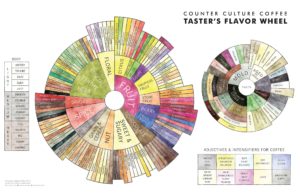
Source: Counter Culture Coffee (3)
When aroma is experienced alongside the taste of the brew, you get the full coffee flavor. The variety of flavors that a coffee can possess is staggering. During my second cupping with Ritual Roasters in SF, the flavors ranged from intensely fruity to savory. The aromas reminded me of teriyaki beef jerky, toasted nuts, and pungent fruit.
Because aroma plays such a huge role in the perception of coffee flavor, you won’t taste your coffee as well if your nose is stuffy or if you have a cold. Additionally, not everyone perceives the same thing when tasting. All you can really do is prepare and drink coffee the way YOU like it.
This article, although immensely fun to write, does not in any way provide a complete picture of coffee’s intricacies. Probably the easiest way for you to learn more about coffee is to simply talk to your barista.
Lastly, a HUUUUUUUUGE thank you to Daria, Jeremy, Aaron, and everyone else at Ritual Roasters in San Francisco who literally spent hours answering all my questions and helping me learn about coffee.
Cheers!
Want to keep up with the conversation? Follow us on Instagram and Facebook for quick updates on seminars, events, and food science!
References
- “Coffee Networks.” Coffee Networks. N.p., 8 Dec. 2011. Web. 08 Apr. 2016.
- “Coffee Talk: Naturals.” The Specialty Coffee Chronicle. The Specialty Coffee Chronicle, 18 Dec. 2014. Web. 02 Apr. 2016.
- “Coffee Taster’s Flavor Wheel.” Counter Culture Coffee. N.p., 19 Dec. 2013. Web. 08 Apr. 2016.
- “Conversation with Ritual Roasters.” Personal interview. Mar. 2016.
- Farah, Adrianna. “Coffee Constituents.” Coffee: Emerging Health Effects and Disease Prevention(n.d.): n. pag. IFT.org. Institute of Food Technologists, 2011. Web. 2 Apr. 2016.
- Hoffmann, James. The World Atlas of Coffee: From Beans to Brewing: Coffees Explored, Explained and Enjoyed. Richmond Hill: Firefly, 2014. Print.
- Kubota, Lily. “Dissecting SCAA’s Water Quality Standard.” The Specialty Coffee Chronicle. N.p., 8 July 2013. Web. 02 Apr. 2016.
- McGee, Harold. “Tea and Coffee.” On Food and Cooking: The Science and Lore of the Kitchen. New York: Scribner, 2004. 441-48. Print.
- “Odor Database.” The Good Scents Company. N.p., n.d. Web. 02 Apr. 2016.
- Sage, Emma. “Coffee Roasting Chemistry: Chlorogenic Acids.” The Specialty Coffee Chronicle. N.p., 11 July 2014. Web. 08 Apr. 2016.
- Staub, Carl. “Chemical Reactions Occurring in the Roasting Process.” Chemical Reactions Occurring in the Roasting Process. Sweet Maria’s, n.d. Web. 02 Apr. 2016.
- “Trigonelline in Coffee.” coffeechemistry.com. N.p., 23 Apr. 2015. Web. 7 Apr. 2016.
- “Using Sight to Determine Degree of Roast | Sweet Maria’s Coffee Library.” sweetmarias.com. N.p., n.d. Web. 08 Apr. 2016.
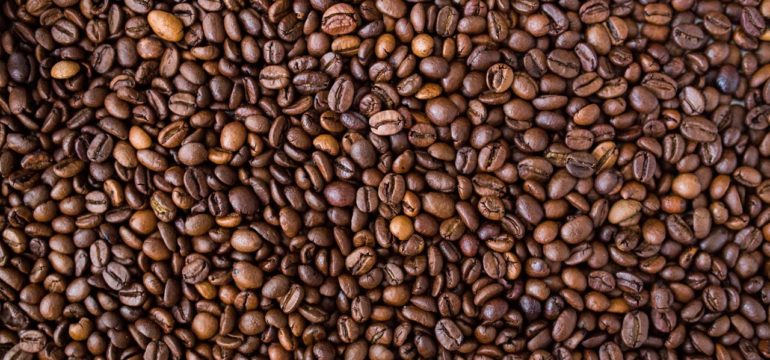





as incredibly informational as this article was, i still was disappointed. it really didn’t adequately answer my own question. mainly, how much does geographic region, soil in particular, affect the flavor of the bean? for example can you take the same species of coffee tree (genetically identical), grow one on the eastern slopes of the andes, then plant the same tree in the distant files of the central highlands of vietnam, go through the exact same harvesting, drying, roasting and brewing processes, and expect for both cups to taste exactly the same? thanks!